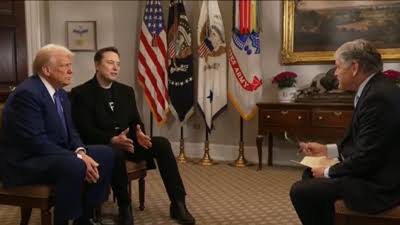Trump pardons Fox News: Trump Elon press conference,Trump’s chief of staff,USA economy

The White House confirmed that President Trump has pardoned former Tennessee State House Speaker Glen Casada. Today we will discuss about Trump pardons Fox News: Trump Elon press conference,Trump’s chief of staff,USA economy
Trump pardons Fox News: Trump Elon press conference,Trump’s chief of staff,USA economy
In November 2025, former President Donald J. Trump made headlines once again by announcing a sweeping set of presidential pardons. The move reignited political debate across the United States, while simultaneously dominating major media outlets — including Fox News, which has long played a central role in shaping Trump’s public image. The same week, Trump appeared alongside billionaire entrepreneur Elon Musk in a high-profile press conference that underscored his second-term priorities: government reform, economic revival, and close cooperation with business leaders.
This article explores the recent pardons, Trump’s alliance with Musk, the evolving role of his chief of staff, and the broader implications for the U.S. economy and media environment. It also analyzes how Fox News has covered and influenced these events in ways that reflect its complex relationship with Trump.
The Pardons: Political Motivation and Strategic Timing

Trump’s latest round of pardons was one of the most extensive of his political career. It included several individuals who were closely tied to his first and second administrations, such as former White House chief of staff Mark Meadows, ex-mayor Rudy Giuliani, and attorney Sidney Powell. All three were prominent figures during the post-2020 election controversies.
The pardons were presented as part of a broader narrative of “correcting injustices” and “restoring integrity,” but political analysts widely saw them as strategic moves to consolidate loyalty and reinforce Trump’s control over his political allies.
In his official statement, Trump framed the pardons as an effort to protect individuals who had “fought to preserve the truth” during what he called a “dark era of political persecution.” Critics, however, saw the actions as clear signs of political favoritism — rewarding those who remained loyal and punishing those who distanced themselves from him.
The announcement came just weeks before Trump’s scheduled economic reform summit, raising speculation that the pardons were timed to distract from ongoing political and economic challenges.
Trump’s Chief of Staff: The Loyal Strategist
Mark Meadows, Trump’s chief of staff during his final months in office, was one of the central figures pardoned. Meadows has long been viewed as both a political strategist and a loyal aide, known for keeping the Trump administration tightly organized around its communications goals.
During the first term, Meadows was instrumental in shaping Trump’s legislative outreach and ensuring coordination with key media outlets, including Fox News. His return to Trump’s inner circle in 2025 signaled a renewed focus on discipline, message control, and long-term planning.
The pardon effectively restored Meadows’ public standing, positioning him as a powerful behind-the-scenes operator once again. Political observers suggest that Meadows’ reinstatement could help Trump tighten his administrative structure — particularly as the president seeks to balance his populist messaging with the realities of governing.
However, opponents argue that the pardon undermines accountability and demonstrates that loyalty, rather than legality, is Trump’s guiding principle. For them, Meadows’ inclusion on the list of pardoned figures confirmed what they see as the politicization of justice.
Fox News and the Media Battle
Fox News has been central to Trump’s political brand since his entry into national politics in 2015. The network provided a platform for his ideas, amplified his rallies, and helped him shape public perception. Yet, the relationship between Trump and Fox has not always been seamless.
In the aftermath of the pardons, Fox News covered the story with a tone that balanced supportive framing and cautious analysis. The network emphasized Trump’s constitutional right to grant pardons, while highlighting the controversy it generated among opponents. This editorial balance reflects Fox’s current position — supportive of Trump’s agenda but wary of being perceived as blindly loyal.
Inside Fox, producers reportedly debated how prominently to feature the story. Some wanted to focus on the economic announcements that followed, while others saw the pardons as the defining moment of the week. Ultimately, Fox dedicated several prime-time segments to the issue, inviting political commentators who defended the pardons as part of a broader effort to “end political witch-hunts.”
Still, independent media outlets criticized Fox News for minimizing the ethical implications and failing to challenge Trump’s motivations. The network’s continued influence over Republican audiences ensures that its framing of these events will play a major role in how millions of Americans understand Trump’s actions.
The Trump–Elon Musk Press Conference: A New Era of Power Partnership
Just days after the pardons, Trump appeared at a highly publicized press conference with Tesla and SpaceX CEO Elon Musk. The event was billed as an “innovation partnership” announcement, but it carried deeper political symbolism.
Trump praised Musk as “the greatest business mind of our generation,” crediting him for bringing efficiency and innovation to government through his advisory role in the Department of Government Efficiency, nicknamed “DOGE.” The partnership aimed to reduce waste, automate bureaucratic functions, and attract private-sector expertise to Washington.
Musk, in turn, thanked Trump for “embracing bold solutions” but subtly distanced himself from some of the administration’s more controversial economic decisions, such as new tariffs and large-scale federal spending increases. His remarks about “streamlining government without over-spending” were widely interpreted as a critique of Trump’s fiscal policies.
The press conference, which was carried live on Fox News and other major networks, quickly became one of the most watched political events of the year. It blended political theater with business branding — a hallmark of Trump’s media strategy.
The optics were deliberate: Trump, the populist leader, standing shoulder-to-shoulder with one of the world’s richest and most innovative figures, symbolized a fusion of political power and entrepreneurial spirit.
DOGE and the Government Reform Agenda
The Department of Government Efficiency (DOGE), an initiative introduced in Trump’s second term, was designed to streamline federal bureaucracy and cut government waste. The agency’s name — inspired by internet humor but taken seriously in policy circles — reflects Trump’s flair for branding even within government.
Under Musk’s guidance, DOGE claimed to have identified over $1 trillion in potential savings by restructuring contracts and reducing redundant programs. However, later reports suggested that many of the projected savings were theoretical, while actual budget cuts amounted to far less.
Critics argue that DOGE’s aggressive reforms led to layoffs, reduced public services, and logistical confusion across federal departments. Supporters counter that such disruption was necessary to modernize a bloated government system that had resisted change for decades.
Musk’s tenure as DOGE’s lead advisor lasted approximately four months before he stepped down, citing “mission accomplished.” His departure was amicable in public statements, though insiders reported tension between Musk’s data-driven management style and Trump’s more instinctive, politically motivated approach.
Economic Landscape: The State of the U.S. Economy in 2025
The economic context surrounding these developments is complex. By late 2025, the U.S. economy was showing mixed signals: consumer spending remained strong, but inflation pressures persisted. Unemployment had fallen compared to the previous year, yet wage growth stagnated for middle-income workers.
Trump’s economic policy platform has revolved around tax cuts, tariffs, deregulation, and increased domestic manufacturing. While these measures boosted certain industries, economists warned that they could worsen long-term debt and raise consumer prices.
The trade war with China and Europe resurfaced during this term, with Trump re-imposing tariffs on steel, electronics, and auto parts. Supporters claim these policies protect American jobs and industries; detractors argue they disrupt global trade and increase costs for U.S. consumers.
The Musk-backed government efficiency drive was part of Trump’s broader strategy to offset the financial impact of tariffs by cutting spending elsewhere. However, the data so far suggests that the savings were modest compared to expectations.
The stock market, once buoyed by Trump’s business-friendly rhetoric, began showing volatility as investors reacted to uncertainty around trade and budget negotiations. The Federal Reserve’s cautious stance toward interest rates added another layer of complexity to the outlook.
The Political Calculus Behind the Pardons
Politically, the pardons serve multiple purposes. They reward loyalty, disarm potential critics, and energize Trump’s base by portraying him as a leader willing to “fight for his people.” The symbolism of forgiving figures like Meadows and Giuliani carries deep resonance among supporters who view the prosecutions as part of a “deep-state” conspiracy.
Strategically, the pardons also allow Trump to reset his political alliances ahead of the 2026 midterms. By freeing his closest associates from legal jeopardy, he strengthens his campaign infrastructure and ensures key operatives remain active.
From a historical perspective, Trump’s use of the pardon power continues his pattern of stretching presidential authority to its limits. Previous presidents used clemency for humanitarian reasons or to correct judicial errors; Trump uses it as a political instrument. Whether this reshapes future norms around presidential power remains an open question.
The Role of Media Optics
In today’s media-driven politics, optics often matter as much as policy. Trump understands this better than almost any political figure of his era. Every decision — from who he pardons to who shares the stage with him — is designed to generate powerful visual narratives.
The Fox News coverage of his press conference with Musk exemplified this strategy. The network highlighted Trump’s “business-government partnership,” framing it as proof that the administration was serious about economic reform. The segment featured upbeat music, triumphant graphics, and positive commentary, all reinforcing the message of success.
Meanwhile, other outlets portrayed the event as political theater — a well-staged but hollow spectacle meant to distract from controversies and economic uncertainty. Yet even critics acknowledge that Trump’s command of media attention remains unmatched.
The pardons, the press conference, and the DOGE reforms together created a media cycle dominated by Trump, ensuring that no other political figure or issue could capture equal attention that week.
Economic and Political Risks Ahead
Despite the spectacle, serious challenges loom. Economists warn that the combination of large tax cuts, ongoing tariffs, and government restructuring could worsen fiscal imbalances. Reductions in federal workforce capacity may also delay essential services and weaken key agencies.
Internationally, trade partners have expressed frustration with Trump’s tariff policies, hinting at potential retaliatory measures. These could harm export sectors like agriculture and manufacturing — two areas Trump has promised to protect.
Domestically, critics fear that the pardons may embolden future officials to act without accountability, expecting similar protection. The perception of favoritism could erode trust in institutions and weaken the rule of law.
Within the administration, tensions remain high between Musk’s data-driven efficiency model and Trump’s political instincts. Musk’s exit from DOGE illustrates that even high-profile allies may struggle to reconcile corporate discipline with political theater.
Trump’s Strategic Narrative
For Trump and his team, however, the narrative remains clear: strong leadership, loyalty rewarded, business innovation embraced, and government waste eliminated. This storyline resonates with his base, which continues to see him as a fighter against entrenched bureaucracy and media bias.
By aligning with Musk, Trump signals to both Wall Street and Silicon Valley that his administration welcomes private-sector expertise. By pardoning Meadows and others, he reminds his supporters that loyalty will always be rewarded. By appearing on Fox News, he ensures his message reaches millions of sympathetic viewers without distortion.
Each of these moves fits neatly into Trump’s political playbook — bold, dramatic, and polarizing. The approach keeps him at the center of public attention, dominating news cycles and ensuring that his rivals remain reactive rather than proactive.
Conclusion
The convergence of Trump’s pardons, the Elon Musk press conference, and the administration’s economic agenda encapsulates the essence of his leadership style: loyalty, spectacle, and disruption. Whether one views these actions as bold or reckless depends largely on political perspective.
Supporters see a president fulfilling promises — cutting government waste, defending allies, and strengthening the economy through innovation and private-sector partnerships. Critics see a pattern of self-interest, favoritism, and media manipulation that threatens democratic norms and economic stability.
The role of Fox News remains pivotal. As both a supporter and a scrutinizer, the network continues to shape the national conversation about Trump’s presidency. Its coverage of the pardons and the Musk partnership illustrates how deeply intertwined politics and media have become in modern America.
Ultimately, the story of “Trump Pardons Fox News” is about power — the power to pardon, the power to shape narratives, and the power to influence an economy through personality and perception. Whether history judges these moves as visionary leadership or political overreach will depend on the results they yield in the years ahead.
For now, Trump stands once again at the center of America’s political and economic theater — commanding attention, defying convention, and ensuring that, love him or hate him, the nation cannot look away.
How useful was this post?
Click on a star to rate it!
Average rating 0 / 5. Vote count: 0
No votes so far! Be the first to rate this post.
About the Author
usa5911.com
Administrator
Hi, I’m Gurdeep Singh, a professional content writer from India with over 3 years of experience in the field. I specialize in covering U.S. politics, delivering timely and engaging content tailored specifically for an American audience. Along with my dedicated team, we track and report on all the latest political trends, news, and in-depth analysis shaping the United States today. Our goal is to provide clear, factual, and compelling content that keeps readers informed and engaged with the ever-changing political landscape.




